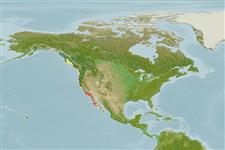>
Eupercaria/misc (Various families in series Eupercaria) >
Sciaenidae (Drums or croakers)
Etymology: Seriphus: Greek, seriphos, -ou, serphos = a mosquito or winged ant (Ref. 45335).
More on author: Ayres.
Environment: milieu / climate zone / depth range / distribution range
Écologie
marin démersal; profondeur 1 - 21 m (Ref. 2850), usually 1 - 8 m (Ref. 2850). Subtropical; 54°N - 23°N, 133°W - 109°W
Eastern Pacific: Yaquina Bay in Oregon, USA to southern Baja California, Mexico. Recorded from British Columbia, Canada (Ref. 11980).
Length at first maturity / Taille / Poids / Âge
Maturity: Lm 10.3, range 10 - 10.5 cm
Max length : 30.0 cm TL mâle / non sexé; (Ref. 2850)
Occur inshore, often over sandy bottoms. Common in bays and tidal sloughs, around pilings. Moves to deeper water at night (Ref. 9118). Form schools. Feed on small shrimps, marine worms and fishes (Ref. 9118). Pelagic spawners (Ref. 56049).
Mean interval between spawnings is about 7.4 days (Refs. 51164, 51165).
Eschmeyer, W.N., E.S. Herald and H. Hammann, 1983. A field guide to Pacific coast fishes of North America. Boston (MA, USA): Houghton Mifflin Company. xii+336 p. (Ref. 2850)
Statut dans la liste rouge de l'IUCN (Ref. 130435)
Menace pour l'homme
Harmless
Utilisations par l'homme
Pêcheries: intérêt commercial mineur; appât: usually
Plus d'informations
Taille/ÂgeCroissanceLongueur-poidsLongueur-longueurFréquences de longueursMorphométrieMorphologieLarvesDynamique des populations larvairesRecrutementAbondanceBRUVS
RéférencesAquacultureProfil d'aquacultureSouchesGénétiqueElectrophoresesHéritabilitéPathologiesTraitementNutrientsMass conversion
Outils
Articles particuliers
Télécharger en XML
Sources Internet
Estimates based on models
Preferred temperature (Ref.
123201): 9.6 - 18.6, mean 11 °C (based on 159 cells).
Phylogenetic diversity index (Ref.
82804): PD
50 = 1.0000 [Uniqueness, from 0.5 = low to 2.0 = high].
Bayesian length-weight: a=0.00575 (0.00278 - 0.01190), b=3.11 (2.93 - 3.29), in cm total length, based on LWR estimates for this (Sub)family-body shape (Ref.
93245).
Niveau trophique (Ref.
69278): 3.7 ±0.57 se; based on food items.
Generation time: 5.5 ( na - na) years. Estimated as median ln(3)/K based on 2
growth studies.
Résilience (Ref.
120179): Milieu, temps minimum de doublement de population : 1,4 à 4,4 années (tm=2; Annual fecundity = 300,000).
Fishing Vulnerability (Ref.
59153): Moderate vulnerability (39 of 100).
